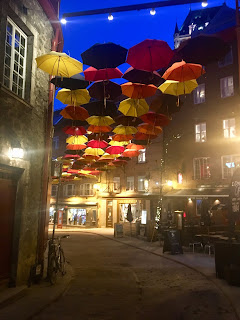As you can see from the image above, Quebec City is truly a whimsical place. PhD student Jake reflects on his experiences in this eastern town while attending the CASI Conference in May.
By Jake Kloos
From May 15th to 17th of this year, I had the opportunity to attend the Canadian Aeronautics and Space Institute (CASI) conference held in Quebec City, Quebec. A few other members of our lab also attended (Paul Godin, Alex Seguin, and John Moores), as did a number of other students in the Earth and Space Sciences department at York. As several attendees pointed out when I spoke with them, York University made up a sizeable contingent of the conference.
This was my second time attending CASI (the first time being in 2016), and my 7th conference overall during my tenure at York. Generally speaking, I enjoy attending conferences, and CASI this year was no exception. I enjoy travelling to new places and hearing about the latest research in aerospace and planetary science. And with each conference I attend, I feel a bit more comfortable standing in front of a crowd and presenting my own work and better able to scrutinize the work of others (as is healthy, and even necessary in science).
This was my second time attending CASI (the first time being in 2016), and my 7th conference overall during my tenure at York. Generally speaking, I enjoy attending conferences, and CASI this year was no exception. I enjoy travelling to new places and hearing about the latest research in aerospace and planetary science. And with each conference I attend, I feel a bit more comfortable standing in front of a crowd and presenting my own work and better able to scrutinize the work of others (as is healthy, and even necessary in science).
Previous posts have already touched on the “conference experience” with respect to one of the larger conferences in planetary science: the Lunar and Planetary Science Conference or LPSC. Due to its increased size, the atmosphere of LPSC is very different from that of CASI’s. Where LPSC attracts nearly 1800 people each year, CASI is more modestly sized, with only a few hundred people attending the biennial conference. With fewer people, CASI feels more manageable: the sessions are smaller in size and fewer in number, making networking a little less intimidating. The tradeoff here is that with fewer people, there are proportionately fewer talks to choose from and posters to look at. For some, this may in fact be a benefit if their research interests are sufficiently narrow. As for myself, I enjoy having a more diverse menu, as my interests are fairly broad.
One aspect of CASI that I rather enjoy, however, is its emphasis on Canada. As a non-citizen and temporary resident of Canada, I enjoy hearing about how Canada perceives their role in the space industry and the ways in which they are contributing to technology development and space exploration. With CASI being a Canadian institution, this is always much discussed, with talks being given by leaders in private industry and government. We were even given a guided tour of one of Canada’s largest aerospace companies: ABB Bomem. Here we were able to see the labs and facilities where ABB was developing a host of instrumentation for space applications, from spectrometers to cameras to other various robotic systems.
This year at CASI, I presented my work quantifying the visible and UV starlight received to permanently shadowed regions of the Moon, where ice may be present. If interested in a more complete description of this work, you can read one of my previous posts here. This research seemed to fit in well at the conference, as there were several other talks pertaining to the detection of volatiles on the Moon (although using a fundamentally different technique from the one we are proposing). It was great to hear from other researchers who are doing similar work to my own. In speaking with them in between sessions, I was able to get more information on the work that they are doing, and their opinions on the current and future state of lunar science and exploration. As it turns out, opinions differ wildly, but that is perhaps the subject of another post.

No comments:
Post a Comment